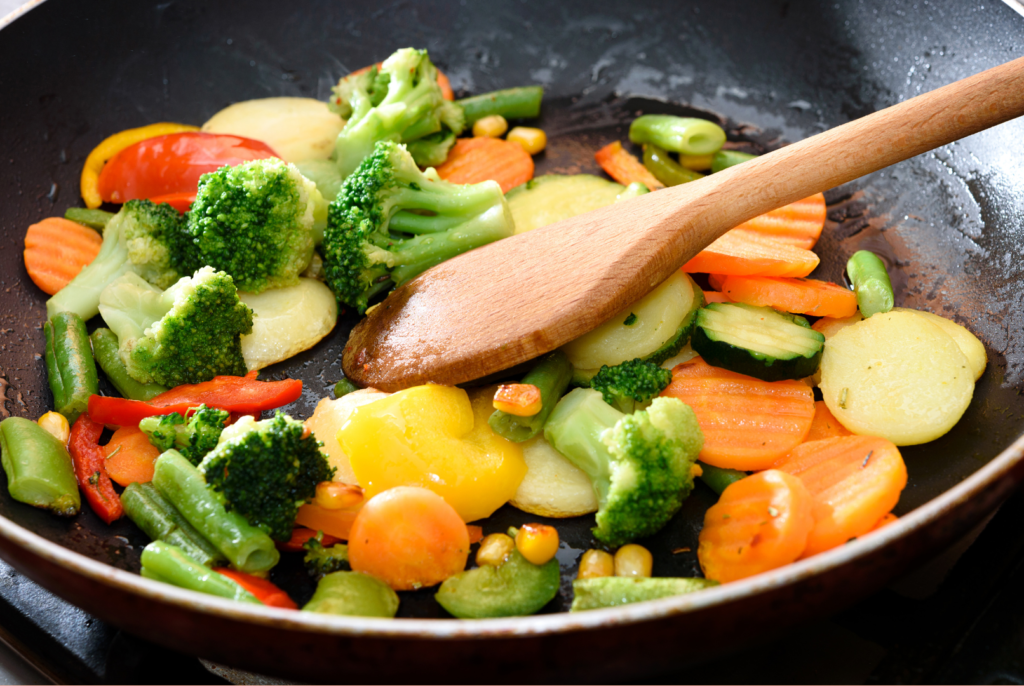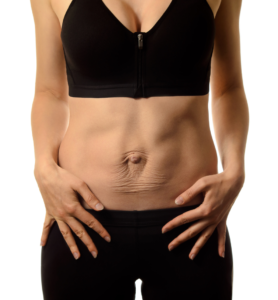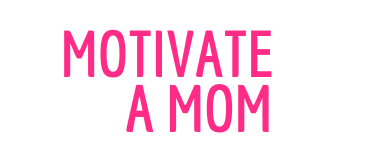Top 5 Tips to Lose Belly Fat After Baby
Is it Possible to Lose Belly Fat After Baby
Are you ready to lose the belly fat accumulated from pregnancy and postpartum? No matter how long it’s been, yes you can still lose that stubborn belly fat! This post will cover the 5 most effective ways to lose belly fat after baby and keep it off.
First, a little appreciation for the mom belly.
That once was the home of your precious child. It stretched for 9 long months and provided warmth and security. You may have stretch marks and loose skin now and those will forever remind you of the hardships and the excitement of meeting your little one.
Even if you don’t love the way your belly looks now, don’t forget the journey it’s been on and take time to appreciate it. This post is meant to empower you to start healthier habits that will result in a healthy body and mind!
Another thing to note is if you are recently postpartum you may still look pregnant. Don’t panic and be patient! It takes around 6 weeks for your stomach and uterus to shrink back down to the size they were before pregnancy (source).
Now let’s get on to tips on how to lose belly fat after baby!
Disclaimer: The content on this blog is intended for informative purposes only, and should not be substituted for medical advice, diagnosis or treatment. If you are postpartum, pregnant or have any health conditions, make sure you have consulted with your doctor first before starting any program.
Eat more Fruits and Vegetables
Before you start restricting calories to lose belly fat, start by adding in foods. We are not just adding any foods though, we want to add fruits and vegetables. It’s important we get your diet in check first and make sure you are eating foods that will help you thrive!
Fruits and vegetables are high in vitamins and minerals, fiber, and water. They have so many health benefits, like preventing some types of cancer, lowering blood pressure, and lowering the risk of heart disease (source).
These foods can also help keep us stay fuller longer and fight cravings, which will help us lose weight. Eating a variety is the key to getting an array of nutrients. You also want to choose fruits and vegetables that are higher in fiber.
Some examples of fruits and vegetables to add to your shopping list for higher fiber are: Berries, apples, avocado, and dark colored vegetables like carrots, beets, kale, spinach, and broccoli.

How much?
It’s recommended to eat at least 5 servings a day. Preferably 3 of those servings from vegetables and 2 from fruits.
Tips for Eating More Fruits and Vegetables
- Start slow. Start by adding a serving and stay consistent for a week. Once you can do that, add in another serving and so on.
- Buy a variety that you actually like and will eat.
- Clean and or cut them so they are ready to eat.
- Find ways to eat them that are easy for you and makes them more palatable.
- Make sure they are in sight so you don’t forget about them.
- Find ways to sneak them into meals. For example, add them to smoothies, pastas, soups, and baked goods.
Increase Protein
Along with increasing fruit and vegetable intake you want to increase protein. Most likely you are getting minimal protein daily.
Protein is beneficial in building and repairing muscle, controlling hunger, boosting metabolism, maintaining bone mass, as well as creating new cells! Yeah, it really is a big deal.
How much?
It’s recommended that 10-35% of your total daily calorie intake is from protein. So if you are eating 2,000 calories a day that equates to 200-700 calories or 50-175 grams of protein. If you are breastfeeding or are active aim to eat on the higher end of the scale.
You can get your protein from a variety of sources. Choose leaner meats like salmon, chicken breast, turkey, and leaner ground beef. You can also get a good amount of protein from dairy products, nuts and seeds, and beans. As well as foods that have added protein like protein shakes and bars.
Drink More Water
Drinking water is another obvious, but commonly ignored habit. Most people just forget to drink water, or they just prefer the taste of something like diet coke.
When you drink water it increases energy, flushes out toxins, improves digestion, and increases mental clarity.
How much?
How much water is required for you depends on a lot of factors, like if you are pregnant or breastfeeding, the climate you live in, and how much you exercise. Start by aiming to drink at least 3 liters of water a day and increase as needed.
If you notice you have a dry mouth, tired, have dark colored urine, slow digestion, or have food cravings then you may need more water!
How to Drink More Water
Whether or not you drink enough water just boils down to habit. Do you make it accessible and a part of your routine?
- Make it a habit by filling a big jug every day and keeping it within your reach.
- Get a jug like this that gives you a time frame to drink it by.
- Drink it first thing in the morning and choose water over soda or juices.
- Find ways to make it tastier by adding flavoring and fruit or making tea.
Increase Movement
Exercise will help you lose stubborn fat. However, instead of just opting for cardio sessions, start with increasing daily movement first.
Simply adding daily activity, no matter how small, like standing instead of sitting, parking further away, and going for a quick walk after lunch will help increase your daily energy expenditure.
As well as daily movement, make sure to add in at least three resistance training workouts a week.
If you need a program, check out this Free Beginner Workout Plan for Moms!
Resistance training will help you build strength and muscle, giving you that toned look. Muscle tissue will help you burn more calories throughout the day and boost your metabolism and fat burn.
Focus on full body compound movements to get the biggest bang for your buck! Don’t just focus on ab exercises. It is a myth that you can spot reduce fat with any exercise! Meaning you can’t just do crunches and expect your tummy to lose fat.
In addition to a full body resistance training program like I recommend above, focus on deep core exercises. If you are a mom, no matter how long postpartum, you may have an abdominal separation.
A separation of the midline of the abdomen is called Diastasis Recti. For many women who have given birth this is due to the necessary stretching of the abdominal wall to make room for baby.

Having a separation that doesn’t regain it’s tension postpartum will create a bulge in your mid belly that doesn’t seem to go away even after weight loss. It can also cause some other unpleasant symptoms like low back pain or incontinence. You may have been checked by your doctor at your postpartum checkup. If it’s been a while and you are unsure you can even check this yourself.
Start by lying down on your back. Take three fingers and press them down on your midline at your belly button. Lift your head up slightly. You will be able to feel your abdominals (6 pack muscles) and if there is a space between them.
Palpitate all along the midline of your belly from your bra line all the way down below your belly button to determine where there might be a separation. If you have a gap that is an inch or about 1-2 fingers or greater then you have diastasis recti.
There are exercises that will help strengthen your core and regain it’s function. Start by making sure you are managing pressure properly through breathing and then incorporate this into exercises that will target the deep core muscles.
Eat Less Processed Foods
Now that you’ve increased your fruits and vegetables and protein it’s time to reduce the amount of processed foods you are eating. Processed foods are any foods that have had additives added to them, like sugar, oil, or salt.
Processed foods are usually higher in fat, sugar, and salt. They are mainly made up of “empty calories” meaning they are lacking many nutrients, like protein, fiber, vitamins, and minerals. Examples of processed foods are sugary drinks, flavored yogurt, cereals, potato chips, cookies, candies, ice cream, and cold cuts.
Eating a diet high in processed foods can increase your risk of disease, obesity, digestive issues, and depression to name a few.
It may not be realistic to cut them out completely, but if your goal is losing belly fat, then reducing them would be a good idea.
Tips on How to Limit Processed Foods
- Find healthier alternatives. For example, snack on fruits and vegetables instead of chips or crackers.
- Reduce the amount you buy so you don’t have the temptation to snack on them at home. Instead keep healthier alternatives available.
- Get majority of your grocery items on the outskirts of the grocery store and go into the store with a list.
- Cook more meals and eat out less.
- Replace sugary drinks with water.
- Buy 100% whole wheat and whole grain when possible.
- Check the amount of added sugars and opt for the option containing less.
If you need more fat loss tips and motivation, check out How to stay motivated to lose weight after baby!
Bonus Tips!
Breastfeeding
If you’ve just had your baby, then breastfeeding can be a great way to shed some stubborn pounds! Breastfeeding requires a lot of extra energy and therefore increases your total daily energy expenditure. The caveat to this is you will be hungrier!
Breastfeeding will burn more calories; but it will require you to eat more calories to keep up with your milk supply. For this reason, it may not always result in weight loss.
Calorie Deficit
You must be in a calorie deficit to lose fat. This can be achieved by eating less or moving more. You should first and foremost focus on eating a diet plentiful in nutrients. Eating a more nutrient dense diet will help you eat less calories overall.
If you have stalled in weight loss, then you can focus on eating less or moving more to lose additional belly fat.
A good place to start is by keeping a food journal to see how much you eat on an average day. From there you can start decreasing portion sizes. Or you can increase your weekly activity. Say you walk 2,000 steps a day, bump this up to 3,500 steps a day for the next week.
Lose Belly Fat After Baby: Summary
Eating a variety of fruits and vegetables, increasing protein, staying hydrated, reducing processed foods, and exercising more will make you feel great and will help you lose belly fat after baby.
Your postpartum belly may be exaggerated from an abdominal separation called Diastasis Recti and you may need to do additional deep core exercises to help mend this. Even if you don’t have Diastasis Recti it doesn’t hurt to implement these exercises into your routine for a strong core!
Once you improve your overall diet and habits, you may need to focus on eating less overall or increasing exercise to lose additional stubborn belly fat.
I hope you start implementing my top 5 tips on how to lose belly fat after baby today! Not only will they help you lose excess fat, but these tips will improve your overall health and help you feel like a super mom
Similar posts about diet and exercise in pregnancy and postpartum:
-
How to Make Time to Exercise as a New Mom [And Make it a Routine!]
-
Must-Do Core Exercise for Pregnancy and Postpartum: Connection Breath


One Comment
Comments are closed.